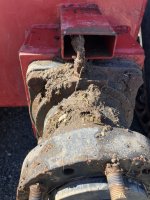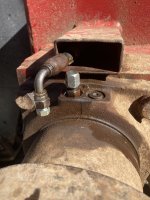ponytug
Super Member
Only an issue for those of you with charging valves or accumulators:
So, I have been chasing a charging valve problem for awhile now. The symptom was that the charging valve would cycle every every minute and a half or so when cold, and ten to twelve seconds or so when hot. Brakes on or off, it cycled. When it was hot, there was a noticeable lock up/freeze to the steering, as well as an audible "thunk" as the valve cycled and the engine took a sudden load.
So I called Power-Trac. (Huge thank you to Terry in all of this!) Terry had me replace the M931 charging valve, and this isn't the first time for me. They usually wear down and leak oil out around the spring. Bright side, I am getting pretty good at replacing the charging valves. My trick is to unbolt it from the chassis and disassemble it hanging over the side. Way more room. I tried, but no luck. I still had a rapid cycle. Then he suggested that perhaps one of the hydraulic brakes was leaking internally, i.e. leaking from the motor to the case drain. To check that involves jacking each corner of the tractor up, removing the wheel, cleaning the living daylights out of the brake hose area; I had pressure washed the whole tractor first and there was still tons of gunk embedded in the channel for the brake hose, especially the front left. I clearly need to blast that area out better after mowing, and dirt moving. So more air blasting and brake cleaner followed by power cleaning with wire brush wheels, rinse, and repeat until spotless. Then you disconnect the brake hose and cap it with a metal (-4 (7/16") on mine) 37 deg SAE male flare plug, and cap the motor with the matching female cap. Power the engine up and time how long it takes the big spring on the charging valve to cycle with the brakes off. (Tractor tires blocked, of course!) Repeat for all four wheel motors. Note to self, and others, try not to do this with chains on the tires as the tires are somewhat tough to slide into place for some reason as the chains do a good job of grabbing. I thought that this would take hours, but it went rather quickly. (That is after I had ordered set of caps and plugs...)
If capping one wheel motor stops the cycling, or significantly delays it, you have found your problem brake. Do all four, just in case you have more than one bad brake.
Mine had no difference. Bummer. Called Terry back.
He suggested that it might be a bad accumulator, or at least an accumulator in need of recharging. Mine is only thirteen years old. I can't imagine why it would need recharging. (joking!) Terry offered to do a rapid service turnaround, if I overnighted the accumulator to Power-Trac, as they are closed for Thanksgiving week. I had a nightmare vision of the shipping company losing the accumulator for a few days and me being without the use of the tractor for a couple of weeks. So, I found a fairly local hydraulic supplier that was willing and able to recharge the hydraulic accumulator ($27!). Quick removal of the accumulator, (plug the charging valve port, or you will have oil everywhere!) drive to the shop, wait while they recharge it (as it turned out, my accumulator was at zero psi), drive back to the ranch, put accumulator back on, and start the engine. Watch the big spring with bated breath. Time the cycle time of the spring. Wait, wait, wait...
No more rapid cycling of the charging valve!
I will be ordering a new accumulator from PT tomorrow, as I am sure that my current accumulator is beyond its useful life at this point. Meanwhile the tractor is running, and I am not sweating bullets if UPS/USPS/FedEx misplaces a package for a few days. I am also not paying a third or a quarter of the price of a new valve just to ship the old one to PT. For the record, accumulators are technically not serviceable in the sense that you can't replace the internal o-ring on the piston, but you can recharge them.
For what it is worth, only the brakes and the accumulator are on the same hydraulic circuit, but you probably knew that already.
Thanks again to Terry, who even called me back Monday morning to make sure that I was set. He is just plain amazing.
All the best,
Peter
P.S. photos
Pre wire brush and air cleaning right front, but after power washing. I did try to clean things out, but clearly I need to do better behind the rims.

After wire brushing and having been blown out with air. The cap and plugs are on and the brake disconnected.

So, I have been chasing a charging valve problem for awhile now. The symptom was that the charging valve would cycle every every minute and a half or so when cold, and ten to twelve seconds or so when hot. Brakes on or off, it cycled. When it was hot, there was a noticeable lock up/freeze to the steering, as well as an audible "thunk" as the valve cycled and the engine took a sudden load.
So I called Power-Trac. (Huge thank you to Terry in all of this!) Terry had me replace the M931 charging valve, and this isn't the first time for me. They usually wear down and leak oil out around the spring. Bright side, I am getting pretty good at replacing the charging valves. My trick is to unbolt it from the chassis and disassemble it hanging over the side. Way more room. I tried, but no luck. I still had a rapid cycle. Then he suggested that perhaps one of the hydraulic brakes was leaking internally, i.e. leaking from the motor to the case drain. To check that involves jacking each corner of the tractor up, removing the wheel, cleaning the living daylights out of the brake hose area; I had pressure washed the whole tractor first and there was still tons of gunk embedded in the channel for the brake hose, especially the front left. I clearly need to blast that area out better after mowing, and dirt moving. So more air blasting and brake cleaner followed by power cleaning with wire brush wheels, rinse, and repeat until spotless. Then you disconnect the brake hose and cap it with a metal (-4 (7/16") on mine) 37 deg SAE male flare plug, and cap the motor with the matching female cap. Power the engine up and time how long it takes the big spring on the charging valve to cycle with the brakes off. (Tractor tires blocked, of course!) Repeat for all four wheel motors. Note to self, and others, try not to do this with chains on the tires as the tires are somewhat tough to slide into place for some reason as the chains do a good job of grabbing. I thought that this would take hours, but it went rather quickly. (That is after I had ordered set of caps and plugs...)
If capping one wheel motor stops the cycling, or significantly delays it, you have found your problem brake. Do all four, just in case you have more than one bad brake.
Mine had no difference. Bummer. Called Terry back.
He suggested that it might be a bad accumulator, or at least an accumulator in need of recharging. Mine is only thirteen years old. I can't imagine why it would need recharging. (joking!) Terry offered to do a rapid service turnaround, if I overnighted the accumulator to Power-Trac, as they are closed for Thanksgiving week. I had a nightmare vision of the shipping company losing the accumulator for a few days and me being without the use of the tractor for a couple of weeks. So, I found a fairly local hydraulic supplier that was willing and able to recharge the hydraulic accumulator ($27!). Quick removal of the accumulator, (plug the charging valve port, or you will have oil everywhere!) drive to the shop, wait while they recharge it (as it turned out, my accumulator was at zero psi), drive back to the ranch, put accumulator back on, and start the engine. Watch the big spring with bated breath. Time the cycle time of the spring. Wait, wait, wait...
No more rapid cycling of the charging valve!
I will be ordering a new accumulator from PT tomorrow, as I am sure that my current accumulator is beyond its useful life at this point. Meanwhile the tractor is running, and I am not sweating bullets if UPS/USPS/FedEx misplaces a package for a few days. I am also not paying a third or a quarter of the price of a new valve just to ship the old one to PT. For the record, accumulators are technically not serviceable in the sense that you can't replace the internal o-ring on the piston, but you can recharge them.
For what it is worth, only the brakes and the accumulator are on the same hydraulic circuit, but you probably knew that already.
Thanks again to Terry, who even called me back Monday morning to make sure that I was set. He is just plain amazing.
All the best,
Peter
P.S. photos
Pre wire brush and air cleaning right front, but after power washing. I did try to clean things out, but clearly I need to do better behind the rims.

After wire brushing and having been blown out with air. The cap and plugs are on and the brake disconnected.

Last edited: